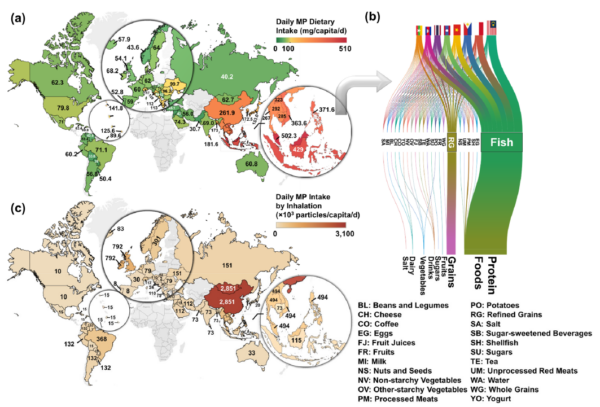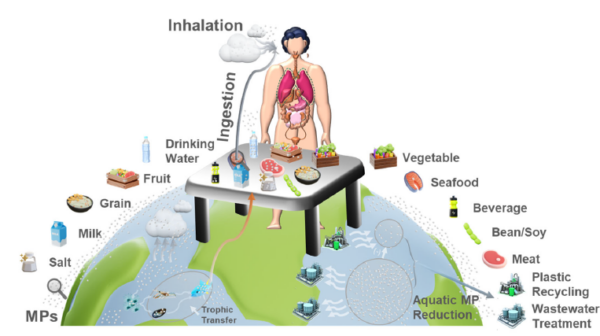Microplastics in Food – How Much?

Researchers from Cornell University conducted a study that produced the first-ever microplastics human uptake map across 109 major countries worldwide. They found that humans often consume microplastics (MPs) in table salt, seafood, meat, and drinks.
Microplastics (MPs), defined as plastic particles smaller than 5 mm, have become an increasing environmental and public health concern. These tiny pollutants infiltrate freshwater and marine environments, eventually making their way into the human body through food. As industrial activities expand, plastic pollution surges, impacting domestic dietary structures and increasing human MP uptake. To address this issue, researchers from Cornell University conducted a study that produced the first-ever microplastics human uptake map across 109 major countries worldwide.
You can also read: Do Plastic Bottles Release Microplastics?
Mapping Microplastic Uptake
From 1990 to 2018, the global microplastics (MP) uptake increased more than six-fold in countries like China and the United States. Indonesia has the highest per capita MP dietary intake globally, reaching 15 grams monthly. This alarming trend calls for immediate action to mitigate the effects of MPs on public health and the environment.
The study maps MP human uptake across 109 countries, emphasizing major coastlines affected by plastic pollution. These findings highlight the urgent need for effective measures to reduce MP exposure and microplastics in food. Removing 99% of aquatic plastic debris by water management for surface water quality control in freshwater watersheds, wetlands, and lakes, as well as ocean cleanups or effective solid waste management, can decrease human MP exposure by 55%. It’s important to note that the intake of MPs in Southeast Asian countries is exceptionally high. Indonesia, Malaysia, the Philippines, and Vietnam are among the global leaders in MP uptake. Therefore, advanced water treatment and solid waste management practices are crucial in reducing MP exposure and associated health risks.

Per capita daily MP dietary and inhalation uptake rates at the country level in 109 industrialized and developing countries within Asia, Europe, Africa, and North and South America, focusing on the world’s major coastlines that are affected by plastic pollution. (a) Per capita MP dietary uptake at the country level. (b) Per capita MP dietary uptake rates at the country level by food types in Southeast Asian countries. (c) Per capita MP inhalation uptake at the country level. The MP intake by air inhalation is measured by the number of particles with size distributions. Courtesy of Microplastic Human Dietary Uptake from 1990 to 2018 Grew across 109 Major Developing and Industrialized Countries but Can Be
Halved by Plastic Debris Removal.
Pathways of Microplastic Uptake
MPs enter the human body primarily through dietary ingestion and air inhalation. Mismanaged plastic waste and industrial activities contribute significantly to this issue. Food like table salt, seafood, meat, and drinks often contain microplastics, which humans consume with these products. The study reveals stark regional differences in MP concentrations. For example, Indonesia and Vietnam show significantly higher microplastics concentrations in food than developed countries like the United States. Moreover, airborne MP concentrations vary greatly, with some regions experiencing much higher exposure levels.

Dietary and airborne MP uptake pathway overview. Courtesy of Microplastic Human Dietary Uptake from 1990 to 2018 Grew across 109 Major Developing and Industrialized Countries but Can Be Halved by Plastic Debris Removal.
Policy and Technological Solutions
Governments worldwide must incentivize the removal of plastic debris from water bodies and enhance waste management practices. Effective surface water quality control, coupled with innovations in packaging materials and meticulous food quality monitoring, can significantly mitigate MP exposure. Replacing single-use polyolefin plastic materials with biodegradable alternatives, particularly in food packaging, is a crucial step towards reducing MP contamination.
Research Gaps
There are still significant research gaps that need addressing. Future research should focus on the detailed investigation of MP pathways and distribution at each trophic level in the food web. Moreover, understanding these pathways will help develop targeted strategies to reduce MP exposure effectively.
The escalating presence of microplastics in the human diet is a pressing issue that demands immediate attention. Industrial development has exacerbated this problem, leading to increased plastic pollution and human MP uptake. By implementing effective water treatment, solid waste management practices, and innovative packaging solutions, we can significantly reduce MP exposure and protect public health. Achieving this will not only safeguard human well-being but also help meet critical SDGs, ensuring a sustainable and healthy future for all.
To read the complete study click here.
